#tropical rainforest reptiles
Explore tagged Tumblr posts
Text

A common green forest lizard (Calotes calotes) on a tree at Sinharaja rainforest in Kalawana, Sri Lanka. Sinharaja is the country’s last viable area of primary tropical rainforest
Photograph: Thilina Kaluthotage/NurPhoto/Shutterstock
#thilina kaluthotage#photographer#nurphoto#shutterstock#common green forest lizard#lizard#calotes calotes#sinharaja rainforest#kalawana#sri lanka#tropical rainforest#nature#reptile
57 notes
·
View notes
Text
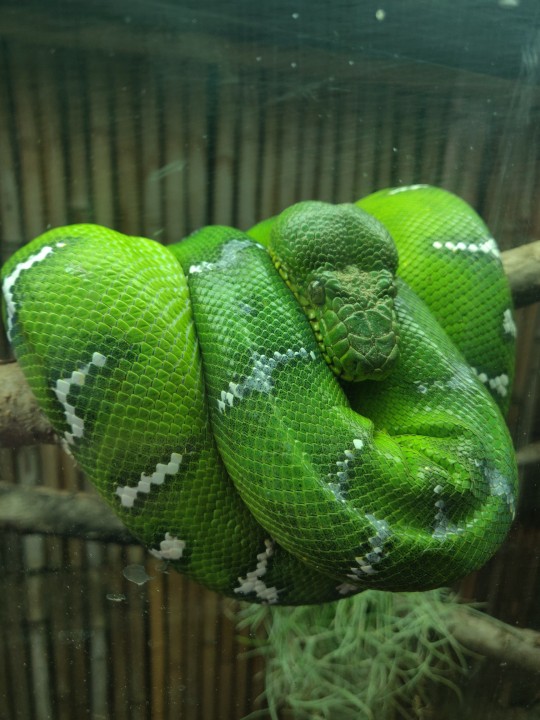

Emerald tree boa (Corallus caninus)
#snakes#snake#emerald tree boa#reptiles#herpetology#south american wildlife#wildlife#mine#zoo#zoos#zoo animals#nature photography#nature#naturalist#photography#ecology#rainforest#tropical
17 notes
·
View notes
Text

1 note
·
View note
Photo

Every window and gap in the jungle hides something magical. The briefest of glances between leaves in the Manuel Antonio National Park revealed the rather biblical Brown Basilisk, famed for running across water and exquisite camouflage. Costa Rica is a fractal paradise - the closer you look, the more incredible it seems. @clever_basilisk @_wild._.life @visit_costarica @manuelantoniopark #basilisk #lizard #reptiles #wildlife #nature #animal #green #wild #natural #naturephotography #tropical #jungle #rainforest #conservation #manuelantonio #manp #chrismilliganphoto #costarica #costaricawildlife #centroamerica https://www.instagram.com/p/CnLO0kDvyQl/?igshid=NGJjMDIxMWI=
#basilisk#lizard#reptiles#wildlife#nature#animal#green#wild#natural#naturephotography#tropical#jungle#rainforest#conservation#manuelantonio#manp#chrismilliganphoto#costarica#costaricawildlife#centroamerica
0 notes
Text

Hundreds of snake species get a new origin story
Elapoid snakes, including cobras, mambas and sea snakes, may have evolved in Asia, not Africa
The ancestors of cobras and related snakes first emerged in Asia roughly 35 million years ago. Many researchers thought the Elapoidea superfamily of snakes evolved in Africa before slithering their way across the globe. But new genetic evidence points to the continent next door to Africa, researchers report August 7 in Royal Society Open Science. The over 700 species of elapoid snakes are extremely diverse, including both highly venomous reptiles like mambas and sea snakes and many nonvenomous species. They’re found in subtropical and tropical regions around the world, in rainforests, deserts and oceans. But the elapoids have long had a murky origin story, says Jeff Weinell, an evolutionary biologist at the American Museum of Natural History in New York City...
Read more: https://www.sciencenews.org/article/snake-species-origin-asia-not-africa
156 notes
·
View notes
Text
Time for a brief break from posting ceramic animals to post some flesh & blood ones (see alt text for species!)!

My partner's mom & stepdad took us to Costa Rica (near Tamarindo) for his 40th birthday & I was in bird/creature heaven! The nearest rainforest was a bit too far from where we were staying, but I got to experience some wonderful dry tropical forest & estuary/river ecosystems, plus got some good hangout time with the Pacific ocean <3
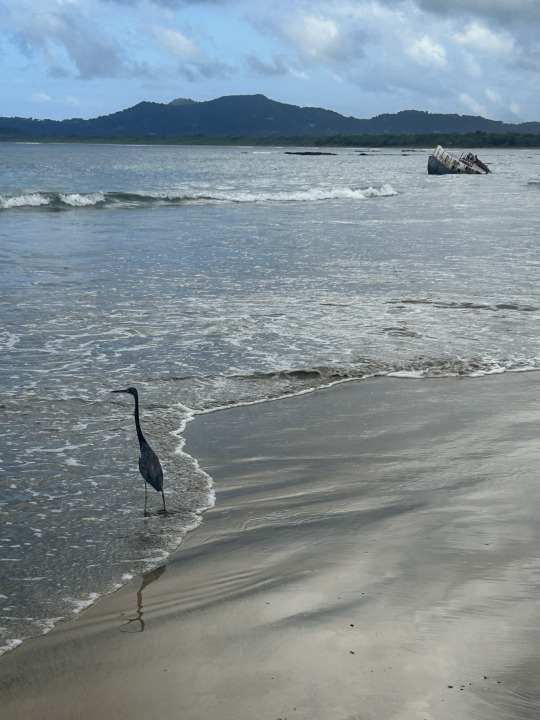
My partner gave me the good DSLR for the nature tours we went on & it was a joy being able to take pretty OK photos instead of sad zoomed-in cheapest-iPhone ones (obviously I still have a lot to learn, but these are exciting as a beginning!!):
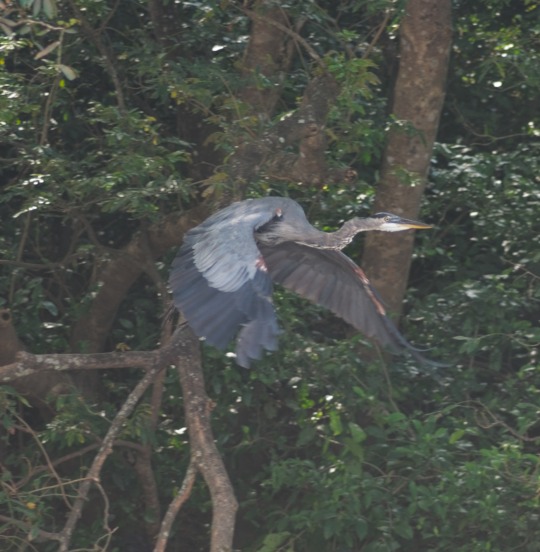

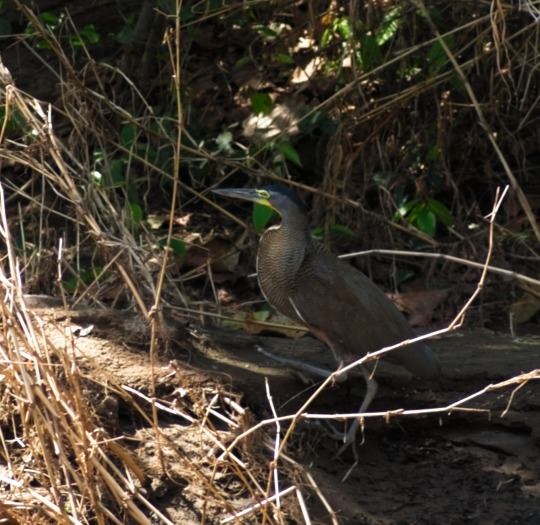
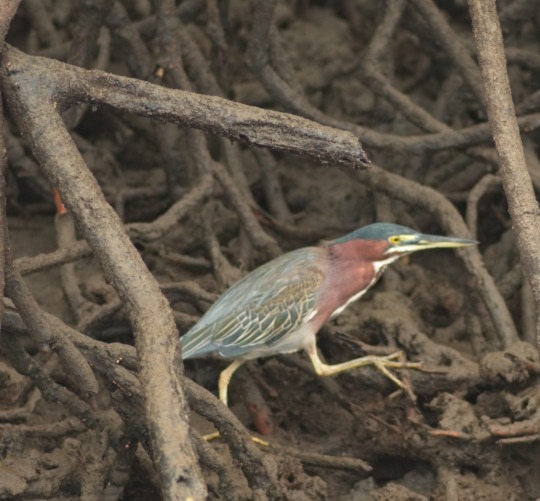
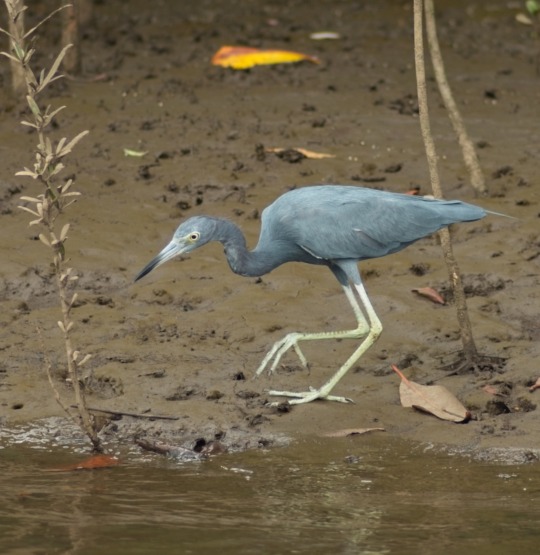
Since our two nature tours were boat-based (one on the Palo Verde River, one on an estuary in Las Baulas park), most of my decent bird photos are herons, as they're larger, generally lower-down, & also move more slowly than goddamn passerines/parrots/smaller birds.
I did get an ok-ish shot of a common black hawk, tho!! LOOK at that eagle-y beak!

& finally, the reptiles!! There were green iguanas & black spiny-tailed iguanas absolutely everywhere...

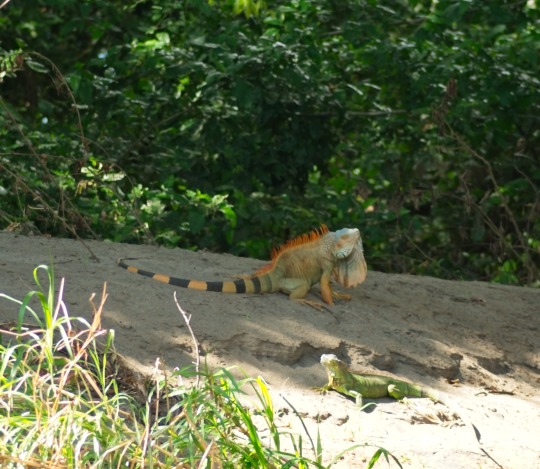
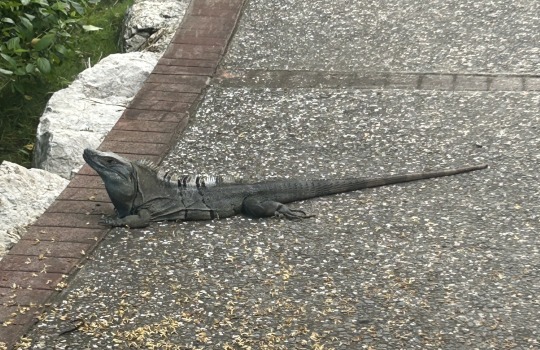
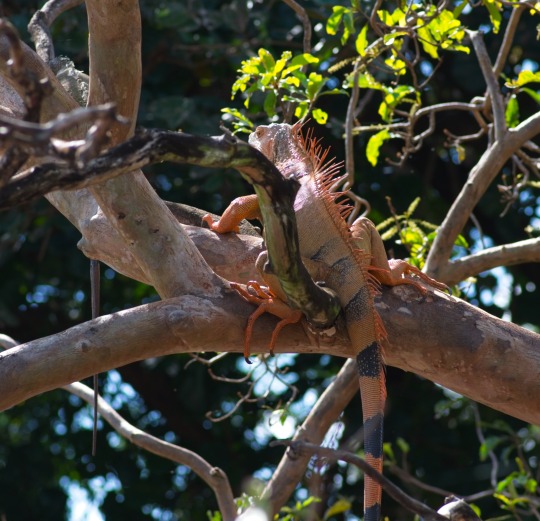
...AND WE SAW AMERICAN CROCODILES!!
On the Palo Verde river tour we saw some BIG guys (smallest maybe 6', biggest must have been 10'-12')!

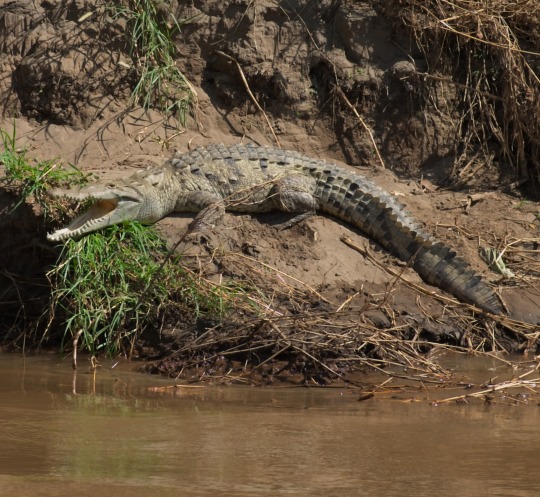
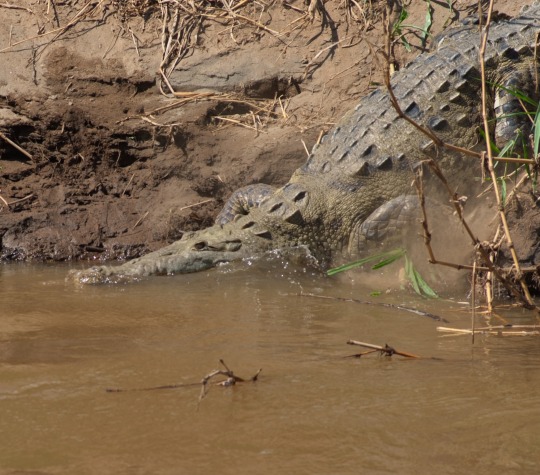
& on the estuary tour we saw a few young ones. Two were less than 3' long, and this guy was maybe 4' and let us get super close b/c it was tucked away in the mangrove roots!

I had a wonderful time on this trip and am already looking forward to coming back for a rainforest-focused adventure next time!!
Also, Tamarindo has two really good coffee shops run by the loveliest people (Nordico Coffee & Derecho Sagrado) so if you're ever there, pls check them out!
FIN!
#artblog#creatures#american crocodile#common black hawk#green heron#little blue heron#great blue heron#yellow crowned night heron#bare-throated tiger heron#boat billed heron#green iguana#black spiny tailed iguana#costa rica#tamarindo
113 notes
·
View notes
Note
So maybe this isn't your exact field since I see you curate dead things and not alive things. Regardless do you know of any common frog pets that you wouldn't condone for pets that people might not know about? For example. You can buy an iguana but an iguanas habitat size and environmental needs often lead to them being in, intentional or not, abusive households for them. I know lots of birds, snakes, and lizards that are like this but I haven't heard much about frogs. Are there any you can buy but probably shouldn't for some or several reasons? Is it ok to keep poisonous tropical rainforest frogs for example? I see some as pets and it seems iffy to me.
This may be an unpopular opinion, but basically I am of the opinion that most people who keep frogs as pets should not be doing so. They require specific environmental conditions that are not always easy to maintain without relatively major investment of both money and time. They also need almost constant access to food (especially dendrobatids), but that diet also needs to be balanced. It is common to see Ranoidea caerulea (White's tree frogs) that are extremely overweight, which is reflective of poor diets. No frogs should be regularly held, but many people take theirs own on a regular basis.
All-told, there are no frogs I know of that I would consider appropriate for beginner animal keepers. Reptiles are often much more forgiving in this regard. But it is also important to remember that no animals should be testers or trainingwheels, especially ones that are as long-lived as some of these. They are a huge commitment. I think that gets forgotten a lot of the time. Tbh, I myself have been guilty of that in the past. But we should work to do the best we can for the animals in our care. And to know our own limitations and abilities, and not acquire animals we cannot care for appropriately.
265 notes
·
View notes
Text

My second spec evo is a predatory chameleon chasing down and catching pterosaurs Species name- Messorem Chamelonitis (Reapers Chameleon) Creator- Titan Diet- carnivorous Clade- Chamaeleontiformes Habitat- Tropical Rainforest and Carbonate Platform Height- 1m Length-1.4m Ecology- Fast ambush hunter/fisher
Additional info- The Reapers Chameleon is a stead fast ambushhunter being able to climb and run down any prey its jaws around. This reptile will mostly target small fish and pterosaur,using an ambush to catch its meal. They are normally solo until till mating season in which they will group together, fully grown males will hissand grown while the smack each other withtheir hard muscular tails, leaving gashes and cuts over the body or even dismemment of toes,fingers or tail. They also posses a large barded finger which it gets its name sakewhich it uses to stab its prey.
#chameleon#predator#prehistoric#speculativeevolution#speculativebiology#speculativezoology#lemuriachallenge#chamaeleontiformes#paleoart#alternatehistory
42 notes
·
View notes
Text
A writer’s guide to forests: from the poles to the tropics, part 8
We’ve made it to the tropics. I hope you enjoyed this, and found it useful in your writing.
Tropical rainforest
Probably the most recognizable of forest environment, and among the most threatened.
Location-Latin America, Africa, Australia, Indonesia, and the Pacific islands in between the tropics of Cancer and Capricorn. Many forests have been felled or heavily altered by human activity.
Climate-Subtropical to tropical, with conditions being wet year round. Rain does not fall all the time, with a defined rainy and dry season. (What’s the difference? Rainy season has rain almost daily while in the dry season you will have to make do with high humidity and morning fog) At higher elevations, nights are cooler, though still well above freezing, and mist and rain are more common(this is why mountainous RF are called cloud forests)
Plant life- This is a tree dominated environment. The understory and forest floor are dark, unless trees have recently fallen. Many small plants are arboreal, nestled in the upper branches of trees. Vines and other climbers use larger plants as scaffolding. In areas of poor soil, tropical pitcher plants (Nepenthes spp.) and bladderworts (Utricularia spp.) get much needed nutrients from animal sources.
Animal life- Rainforests are the most biodiverse environments on Earth. Insects are everywhere, as are the animals that eat them. Birds and primates can be found from the canopy to the forest floor. The moist conditions make for an ideal habitat for frogs and toads. Apex predators are the big cats-think jaguars, tigers and leopards. Some species of herbivores can be quite large; Africa is home to gorillas and forest elephants, while the island of Borneo, Sumatra, and Java support rhinos and orangutans (though the further of these species is uncertain)Waterways are home to all sorts of fish(there are more species in the Amazon river than in the Atlantic Ocean), and larger animals, such as otters, crocodilians, and even river dolphins. Isolated islands have far fewer mammal species, with bats being the only ones, but hardy insects, reptiles, and birds making up the majority of the biomass. Deforestation and the introduction of invasive species have caused the extinction of many animal species, with island forests being the hardest hit.
How the forest affects the story- When one thinks of societies in the tropics, it usually is through the lens of western stereotypes designed to shock audiences and give ‘civilization’ something to conquer. Avoid this at all cost! There is more to the forest. Before the Spanish conquest, the Amazon was home to cities, and the agricultural societies of New Guinea are believed to be contemporaries with the farmers of Mesopotamia.
Grain does not do well in the tropics, so farming will be based around plants such as açaí, coconuts, taro, breadfruit, bananas, and manioc. These can be supplemented by hunting and fishing, but long term storage will have to be addressed. High humidity is a breeding ground for bacteria and fungi, so organic material will have to be kept dry so they don’t rot. The concentration of microorganisms also means that good hygiene is needed to avoid disease.
Settlement will always cause disruption, and the extent of your character’s activities can have a big impact on the forest, and your story. And remember, the activity of a small village will be different to that of large scale logging. Management, use, and abuse of the rainforest can be a driving factor in the plot. How will your characters react? Is the threat from outside or from within? The destruction of the rainforest is one of the main factors, along with unmitigated greenhouse gas emissions that is causing the current climate crisis. Can your characters do better? Or will you create a cautionary tale that shows us the grim future we are currently barreling towards? (That choice, my dear writers, is completely up to you)
#writing#creative writing#writing guide#writing inspiration#writing prompts#writer#writers#writer on tumblr#writeblr
33 notes
·
View notes
Note
Hey! This might be a kind of stupid (or insensitive) question but I was wondering about mosquitos. I’m actually pretty chill with most insects but they bite, spread diseases and a whole host of other things. I know there are a lot of scientists working right now to reduce mosquito fertility rates which I’m broadly supportive of, but I’m not sure what the unintended consequences are. Like….. would we as a species be okay if mosquitos were eradicated?
it’s entirely a valid question, and a point I hear raised a lot. the answer depends on on how far-reaching your question was intended to be:
an important thing to understand is that there are over 3500 species of mosquito, and of those, only 88 are known to transmit diseases to humans, with about 200 more that potentially could become human disease vectors (Yee et al.) most mosquitoes drink nectar—both males and females—but females typically (but not in all species/forms) require a blood meal from mammals, birds, reptiles, amphibians, or even other arthropods and invertebrates.
if all mosquitoes were “eradicated,” there would undoubtedly be some very bad effects on the environment, although in the utmost selfish view I’m not fully sure how long they’d take to affect humans.
many plants are pollinated by small flies (like cacao! you can thank biting midges for all your chocolate) and certainly some only by mosquitoes. mosquito pollinated plants likely include many in tropical rainforests, where mutualisms between tiny, unusual species are very common, and oddly enough in the Arctic, where soggy summers create a whole lot of mosquitoes.
likewise mosquitoes are likely an important part of the diets of many bats, birds, spiders, dragonflies, other flies, and fish that might eat the larvae, among many others (including mosquitoes that eat other mosquitoes as larvae, like the beautiful Toxorhynchites). the negative effect on these animals in turn could affect their predators, or all the other ecosystem. if all mosquitoes disappeared, there would probably be significant upheaval across global environments, although I don’t know enough to say exactly what the end result would be. making all mosquitoes go extinct would be a very bad idea though, so it’s a good thing humans have no reason or capability to do that.
but people probably don’t have the 3,000 other mosquitoes in mind when they’re trying to control the flies, it’s that 88 to 300-ish bunch that bite humans and transmit diseases. first off, any genetic/sterility control method that targets non-native mosquitoes is most likely to have only good effects. non-native mosquitoes are reduced, people are bitten less. good on both counts. (it’s still possible certain things might be upset, such as if native species have adapted to use non-native mosquitoes, or if the non-native ones were outcompeting some even worse species. don’t know enough to say.) In many places, this is precisely what’s happening, with Aedes being sterilized, modified, or infected with bacteria that cause some reduction in offspring where it is invasive.
as for eradicating mosquitoes in their native range… it gets a bit tricky. I’m not enough of an ecologist or mosquito biologist to give a clear answer here. I also don’t know if there’s consideration of using control methods like you mentioned on species in their native range.
your question was about making mosquitoes go extinct, though, so I’ll focus on that.
would losing a few species of mosquito that are particularly dangerous to humans result in ecological upheaval? I don’t know. ecology is vastly complicated and when people make big decisions involving pests, we can often make problems way worse, like all the times a predator was introduced and started killing off things we didn’t think they would (this has happened with mosquito control, by the way). extinction only goes one way. I’d say in a hypothetical situation where I could just *poof* away an entire mosquito species, I probably wouldn’t do it. we just don’t know enough about the world yet to make decisions like that.
that’s not to say there aren’t ecologically and human-friendly ways to solve the issue of mosquito-borne disease—reduction of manmade breeding pools, careful biological control, targeted, safe pesticides—and maybe in some cases, sterilization or genetic control are part of the solution. but if it comes down to extinction or not, we’d better consider things very carefully before swatting at entire species without knowing what might happen after.
some of the links to the articles I used to research a bit for this post. read them if you'd like, they're fascinating!
238 notes
·
View notes
Text
FEBUZOIC DAY 2
Colombia - Selandian Stage, 60Ma before present
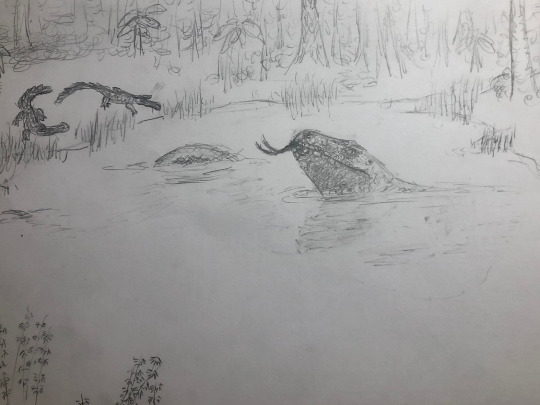
It has been 6 million years since the asteroid impact that brought the Mesozoic era to an end, and the world has recovered. Lush green forests cover the wet of the Earth once more, no longer strangled by clouds of ash, and the seasons pass by in their normal state. It has, however, been getting considerably hotter during this time, and this has shaped the emerging world of the Cenozoic. A new biome has come to dominate the inflated tropical regions of the equator; tropical broadleaf rainforest, an ecosystem type synonymous with this climate today.
It is not just the flora that has been shaped by this heating world, but the fauna. Cold-blooded reptiles have done exceptionally well post-extinction, with their slowed metabolisms, which had increased their chance of survival during the cold, harsh decades after the impact, now speeding up in the heat, allowing them to dominate the megafaunal roles of the Palaeocene world.
Winding his way through the waters of the Cerrajon wetlands is one of the largest Palaeocene reptiles: Titanoboa. Although this giant snake is mainly piscivorous, other local animals give him a wide berth as his size and the potential crushing power of his coils prove no match for other predator in his environment.
#titanoboa#palaeontology#palaeostuff#anthem posts#anthems art#palaeoblr#palaeocene#paleontology#febuzoic 2024
12 notes
·
View notes
Text
While most of the stuff I post in this blog is going to be Australia oriented given that's what I'm most knowledgeable on (and have the most resources for), I also want to occasionally branch out to talk about wildlife from surrounding landmasses every so often - wider Oceania, Wallacea, and generally anything east of the Wallace Line (where the animals become funni). Today, I wanted to start off by briefly introducing one set of islands I find to be particularly overlooked, the Solomon Archipelago, better known as the Solomon Islands.

(Image credit: Wikimedia)
Isolated ever since they first rose above the waves 40 million years ago, the Solomon Islands has been dubbed the ""the Galapagos of the Western Pacific" by renowned mammalogist Tim Flannery for the sheer uniqueness of its fauna. Sitting to the east of New Guinea, the archipelago consists of seven main islands and thousands of smaller islands that vary greatly in size, from impressive volcanic islands like Kolombangara to countless tiny coral cays. Naturally, the islands are clothed almost entirely in tropical rainforests, from lush lowland jungles to misty cloud forests over 2,000 metres above sea level, with some areas of seasonal dry forest and grassland on the on the northern slopes of Guadalcanal being the main exception.
Despite its close proximity to New Guinea (and therefore continental Australia), the Solomon Islands possess no native marsupials - instead it is a world of giant skinks, coconut-eating bats and mysterious rodents.
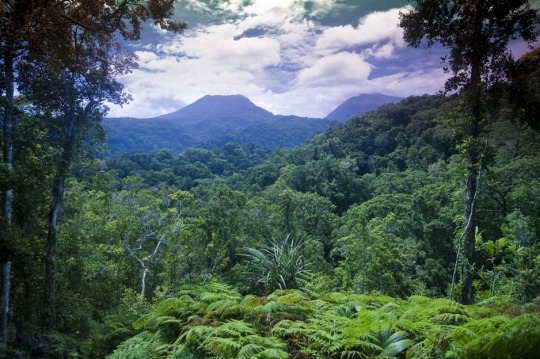
(Image credit: Tourism Solomons)
Easily the most famous animal from the Solomon Islands is the prehensile-tailed skink (Corucia zebrata), also known as the monkey-tailed skink or simply as the Solomon Islands skink. These are the largest of all living skinks, measuring up to 81 centimetres in length, and they are adapted to an arboreal way of life, feeding on leaves, fruit, flowers and fresh shoots. Like many skinks in the subfamily Egerniinae, the prehensile-tailed skink also has a pretty highly developed social life, more like that of a mammal than a typical reptile. They live a social group known as a circulus, in which different individuals band together to protect each other's offspring, and some pairs have even been known to practice long-term monogamy (practically "mating for life").

(Image credit: Johnathan Richmond)
After big skink, the fauna of the Solomon Islands instantly drops into the territory of "obscure creature even most animal nerds don't know about", but they are no less remarkable or unique. Take the monkey-faced bats (Pteroplex) for example. As their name suggests, this endemic genus is notable for their highly unusual thick head shape, which gives them a vaguely monkey-like appearance. The resemblance to primates is no coincidence, for the lack of competing mammals on the islands aside from a few rats has led them to take up a lifestyle unlike that of any other bat. Their canine teeth are enormous, and what's more, possess a double cusp - something completely unique among mammals. Their boxy, powerful jaws and complex teeth are designed for tackling particularly tough fruits and nuts, and they are well known for their ability to crack into green coconuts. There are five species of monkey-faced bat scattered across the Solomon Islands, with the largest being the greater monkey-faced bat (P. flanneryi), which can have a wingspan of over 1.5 metres and weighs in at about 800 grams.

Guadalcanal monkey-faced bat (Pteralopex atrata), juvenile (Image credit: Johnathan Richmond again, legend)
(also kinda irrelevant here but I really gotta talk about the Fijian monkey-faced bat sometime. what a knee slapper)
However, bats aren't the only coconut crackers on the Solomon Islands, for they are also home to several genera of rats that reach pretty gargantuan sizes. The largest species is Poncelet's giant rat (Solomys ponceleti), which reaches over a kilogram in weight and has quite an unusual appearance, with long but sparse dark brown hair, pinkish-white skin and a crest or mane down the back - unfortunately I cannot find any photographs or even illustrations of this species online. The impressively named emperor rat (Uromys imperator) was almost as large, but it is only known from 3 specimens collected in the 1880s and is now considered to likely be extinct. In a demonstration of how much of the Solomons remain under-surveyed however, a new species of giant Uromys, the vika or Vangunu giant rat (U. vika) was discovered by westerners only in 2015, although it had been known to the locals for far longer. This orange-haired coconut-chewer is unfortunately only known from a single specimen for now, but it weighed in at 0.5-1 kg and now represents the largest known member of its genus on the islands.

The only photograph of a living vika (Image credit: O. Revon)
Also just to keep with the pattern of everything being giant (and therefore cool), this huge frog, the giant webbed frog (Cornufer guppyi), also calls the Solomons home. I don't know much about them but they seem like cool guys.
Remember this is only meant to be a brief overview! Would love to talk more about the Solomons sometime, as well as more in-depth about the species featured here.
#oceania#solomon islands#islands#wildlife#animal facts#skinks#bats#rodents#frogs#natural history#infodumps#my stuff
21 notes
·
View notes
Note
For the Digimon partners game: I just graduated from college where I took Environmental Technology and and am now working as a Water Resources Technician. I love freshwater ecosystems, especially wetlands and anything to do with benthic macro invertebrates. My favourite animal is the spotted hyena, with black rhino, timber wolf, and secretary bird all close behind. I love collecting rocks. My favourite colours are yellow and pink. I am almost always doodling, and am usually drawing monsters when I am. Monster collecting is my favourite genre of basically anything. Be it Pokemon, Digimon, Spectrobes, Shin Megami Tensei, Yo-Kai Watch, Yu-Gi-Oh, what have you. I like to read a lot, especially fantasy. Of the original Digimon crests, Hope has always resonated with me the most. And I think that's about it. I personally already have 2 Digimon in mind for myself so I'm curious what you come up with!
I decided to run with the aquatic environment vibe and go with a water and nature theme. For the Child/Rookie level I'm going with red Otamamon, since red is close to pink and a tadpole is definitely the kind of thing you'd find in wetlands.

At the Adult/Champion level, the tadpole becomes a Frogmon. It's yellow and has a plant theme to really it a wetland environment.

To keep up a mix of plant and amphibian/reptile Digimon, the Perfect/Ultimate level I picked is Tropiamon. I can definitely see this one living in a tropical wetland like a bayou or rainforest lake.

Keeping up the plant reptile trend at the Ultimate/Mega level I picked Xuanwumon/Ebonwumon. Even if it's a tortoise instead of a freshwater turtle, I can see it living in a swamp or other wetland.

I tried to go for benthic invertebrate but there just aren't that many options other than Syakomon and Shellmon. If you're ok with oc Digimon I could also partner you with my original hermit crab line. Either way, I hope you like this line.
5 notes
·
View notes
Text
Multituberculate Earth: Eocene
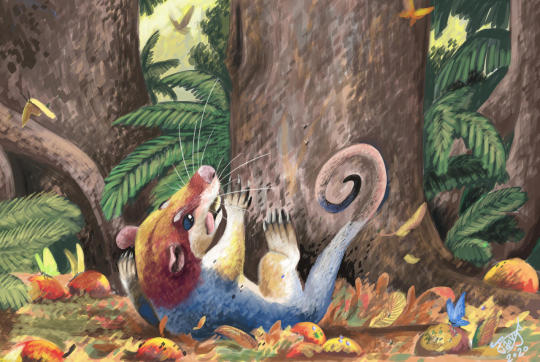
After the PETM, the world became a hothouse planet. Tropical rainforests stretched from pole to pole and sea levels rose exponentially. In our world, these paradisiacal conditions were actually fairly short lived, due to the Azolla Event, but there this does not happen in this timeline for reasons you’re about to find out. Thus, the Eocene truly is a tropical earth from beginning to end, and in these prolonged warm conditions live thrives.
Reptiles most assuredly benefit from this tropical world. Though squamates aside from snakes are no longer here with us, allocaudates and sphenodontians diversify like crazy, some of the latter even attaining megafaunal sizes. Crocodylomorphs diversity both as terrestrial sebecians, planocraniids and mekosuchines as well as various aquatic forms, including marine dyrosaurids and gharials. Turtles do much the same, the seas having several lineages while tortoises debut on land. Birds, the sole living dinosaurs, diversify in ways similar to our world, with large flightless gastornithiforms, ratites, penguins and plotopterids as well as massive flying pelagornithids and lithornithids, but the specific make-up of their diversity will change drastically as the cooling conditions that killed off some groups and allowed some modern groups to thrive never came about.
Mammals are no different. Therians may be reduced to a few relics soon to die out, but gondwanatheres, dryolestoids, monotremes and of course cimolodont multituberculates thrive.
In the northern continents rising sea levels decrease the formation of land bridges and thus four unique faunas develop:
North America is probably the closest to “Paleocene classic”, with taeniolabidoids as the largest land herbivores, ferugliotheriid gondwanatheres as small to mid-sized herbivores and carnivorous ptilodontoideans, eucosmodontids and microcosmodontids occupying various carnivore/omnivore tiers. But adalatheriids and lambdopsalids have arrived from Asia, meniscoessids are gone, and microcosmodontids now threaten the supremacy of ptilodontoideans, some being the de facto apex predators.
Asia has changed drastically due to the collision with India. Gondwanatheres now run the show as far as herbivorous niches are concerned, with only lambdopsalids remaining otherwise. Ptilodontoideans, eucosmodontids and microcosmodontids all vie within predatory guilds, the former two also forming the bulk of arboreal forms. Relictual kogaionids cling to India and Southeast Asia.
Europe is now an island continent. It retains some Paleocene groups (taeniolabidids, ptilodontoideans, microcosmodontids, eucosmodontids, boffiids) alongside new arrivals from North America (ferugliotheriids) and Africa (galulatheriids). Overall, mammals are rarely the largest land animals, that title going to birds like gastornithids.
Balkanatolia is also an island continent, but dominated by kogaionids in predatory roles and meniscoessids and galulatheriids as herbivores.
Africa sees the arrival of ptilodontoideans and boffiids, occupying primate and rodent like niches respectively. However, galulatheriids and kogaionids still rule the show, composing most of the megafauna. The neighbouring Madagascar shares a similar faunal composition, albeit with sudamericids and adalatheriids instead of galulatheriids.
South America, Antarctica and Australia share a similar faunal block with ferugliotheriid, greniodontid and sudamericid gondwanatheres as herbivores, monotremes as piscivores and molluscivores, ptilodontoideans as arboreal omnivores and carnivores and dryolestoids in a myriad of roles from small insectivores to giant herbivores and apex carnivores. Recently, galulatheriids and African ptilodontoideans have arrived to South America, resulting in some ecological turnovers as the natives adjust to these newcomers.
In this tropical world, mammals aren’t just satisfied with the ground. For the first time multituberculates and dryolestoids take to the skies, mirroring the evolution of bats in our world, albeit instead of one lineage of flying mammals there are several. The first marine mammal is the taeniolabidoid Iqiqquq, an animal which will leave no long term descendents but will have drastic ramifications for this timeline. Other mammals will venture into the seas, but for now it is the marine reptiles that rule.
The Eocene hothouse conditions will keep going until the very end. Carbon was sequestered far more slowly than in our world, but eventually enough was that, in combination with Antarctica’s isolation, it causes a rapid drop in temperatures. Combined with the collision of Europe, Balkanatolia and Asia and subsequent faunal exchange, this will cause another but larger extinction event, the Grand Coupure.

Table of contents:
Azolla Shmolla
The Last Placental
Example Site: Uzunçarşıdere Formation
The Grand Coupure.
#multituberculate earth#multituberculata#multituberculate#spec evo#speculative evolution#speculative biology#speculative zoology#paleoblr#palaeoblr#palaeontology#paleontology
32 notes
·
View notes
Note
Idk anything about keeping reptiles but I was curious. Are you able to keep them in the same tank, or do you have separate tanks for each one?
Hello! Unfortunately they’re not able to stay together, they each have to have their own tank. A lot of species are loners naturally, and they each need different temperatures and climates to live in. My bearded dragons tank has to replicate a dessert with the heat and dry air along with some sand for digging, my Savannah monitor needs the heat but more humidity and water to swim in, and my Crested Gecko needs a tank that’s similar to a tropical/rainforest climate. So lower heat, but very humid with soil/moss.
It’s very fun to have three different species with so many different needs!
14 notes
·
View notes
Text
ARGONUS FAUNA: beast of sonias
(NOTE: descriptions copy-pasted from DA where i normally/originally post my works. any context that is missing here on tumblr can be found on my DA [linked here and on pinned post] )
[additional note: much of the first several post on argous's fauna use a human to scale instead of an E-class aircraft like i would end up doing later on. thus, animal's actual size relative to their world will be smaller. a bonus note to make is that this human perspective also includes names of the animals, so i'll be giving out alternate names and/or some explanation....]
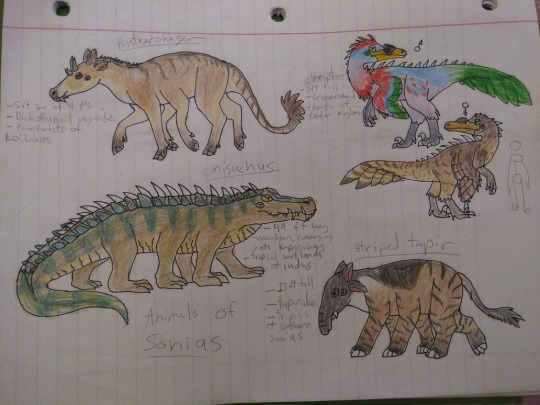
so now we head over to the asia of argonus, aka sonias.
not unlike our asia, and also like other parts of the world, sonias has some interesting and unique fauna. not surprisingly (especially with these guys i drew), most of these weird wonders come from the jungles where diversity is at it's fullest. actually, alongside arid biomes, tropical climates are a hotspot for some of the "living fossils" of argonus...for some reason...
pantheronager -5ft at hips -dichobunoid ungulate -rainforest of KO laos (kingdom of laos)
looking like the hybrid between a deer, horse and cat, pantheronagers are neither those three and are instead a "cat-sized" dichobunoid, an ancient group of ungulates more closer to whales and hippos. the surviving dichobunoids that exist in the sonian tropics aren't too different from their ancient relatives in terms of looks and behaviors, and the panteronager is no exception typical of it's relatives, they're fleet-footed browsers that feed mostly on the foliage and fallen fruit within the forest floor. males are solitary most of the time (excluding mating season), while the females live in small groups of 2-4 with one of them being the alpha. however, unlike other species of surviving dichobunoid, they (alongside the other members of it's genus) have horns and tusks, two pairs each in true argonian fashion. both males and female have them; males use them to fight other males over territory and mates, females use them similarly to establish the pecking order, and both also use them a protection if cornered. every season, males will find a harem and mate with all the females, then leave once the fawns are born. the panthonagars have been kept in captivity for quite a while. they're rather infamous in the pet trade, due to their high reproductive rates (females can have 2-3 fawns every 3 months) and rather surprising adaptability. this has lead them to become introduced into other tropical climates in cities and towns, though their saving grace from becoming completely destructive are the equally abundant introduced/adaptive predators , especially the stunnits and avibels aeronoids.
olmraptor -8ft tall -dromaeosaurid -forests of center kingdom.
there are lots of "living fossils" with dinosaurs being no exception. this is probably because the kpg extinction event wasn't exactly like our own. instead of one big asteroid killing off the dinosaurs, a mixture of volcanic activity and a tiny dash of climate change had the Mesozoic reptiles start to fizzle out in the beginning of the Paleocene, leaving behind only the lucky ones that were adaptable enough to survive the changes. one of these lucky archosaurs to make it to the modern Holocene were the dromaeosaurids, more specifically the "Asiatic" members of velociraptorinae. such is the case with the olmraptor, a forest-dwelling descendant of those velociraptors. the olmraptor, like all other non-avian/pterosaur archosaurs, have a line of spikes going down their backs. they're solitary hunters, preferring to catch small prey like rodents, invertebrates, lizards and birds. although diurnal, they're most active during the brighter hours of dusk and dawn. the male and female mate for life and, despite their solitary lifestyle, have their territories overlapping each other. every year, the male's coat becomes brightly colored, and they begin to start their collection of flowers and bones. when the male first starts this display, the collection starts in a small, shallow pile of grass and twigs. if he's lucky and manages to successfully gain the love of a female, they'll make that display pile into a nest and he'll use it every year to renew their love. both parent incubate the eggs, with the female doing most of the incubating as the male either gathers food or defends the female. when the babies hatch, they're almost fully developed and are able to start walking within their first hour of their life. once able to walk, both parents and offspring leave the nest where the babies are taught how to survive on their own. next season, they'll come back to that nest to start the process all over again. like the pantheronager, they're kept as pets and are infamous for their high reproduction and adaptability. however, they are at least a little helpful in hunting and eating unwanted pest. olmraptors in the western hemisphere (especially amerigia) are popular in places like parks, country clubs and gated communities for their colors and pest control.
onisuchus -49ft long -crocodilian, converging onto kaprosuchus -tropical wetlands of indus sometimes what seems to be a living fossil is actually just an animal converging onto a similar build to prehistoric animal. modern crocodilians are sometimes considered living fossils, given how alot of them haven't changed in the 100 millions of years being here. in some funny twist, most of the seemingly "mesozoic survivors" crocodilians aren't really that and are instead just a case of convergent evolution, such as the case with the onisuchus. the onisuchus is a massive carnivore who's claim to fame is it's kaprosuchus-like looks and it's voracious appetite. they'll eat practically any animal they see fit for a meal, dead or alive. they're just as good swimmers as they are runner, and can run in short burst of speed to catch prey. they even have a body count; about 150 people per year, mostly humans and smaller elkinets, have their lives taken by this gluttonous archosaur. however, not everything is doom and gloom for the onisuchus; like all other surviving crocodilians they're great mothers that protect their young and move them away from danger (mostly other onisuchus). at least 2/3rds of all onisuchus-related deaths are due to people being unaware of a mother onisuchus's presence, or even the babies since they hang around dense foliage to further be protected. when the mother spots the threat, she'll not only kill the animal (or person), but also will ensure that the carcass wont attract other predators by eating their dead body. still, even with all these protective measures, lost of predator's still manage to steal her babies, and only 3 out of 10 of her babies will make it to adulthood.
striped tapir -13ft tall -tapiridae -tropics of southern sonias
one of the very rare instances of an argonian species replacing an earth's species entirely, the striped tapir (aka baku to many humans) was though to be some kind of extreme argonian variation of the Malayan tapir, when in fact they're a completely different species that replaces the Malayan tapir entirely. like alot of perissodactyls, they have a semi-long tail, with the long hair making up a third of it's length. and, like most other tapir species on argonus, they also have tiny, little tusks on their mouths. the behavior is not too different from other tapir species. they're mostly solitary, eats leaves and shoots, most active at night, and can be considerably dangerous when cornered (though the prefer to run first).
if the tapir's ears look a bit weird, that's because i accidentally gave it two ears instead of four and didn't notice until i was typing this. so, i used mspaint as a makeshift photoshop and it surprisingly worked.
also, fun fact, the male olmraptor's colors are based off of the mononykus reconstruction from the weird & wild creature cards.
#mythology#tapir#ungulate#dichobunoid#dromaeosauridae#xenobiology#convergent evolution#speculative evolution#velociraptorinae#speculative biology#kaprosuchus#speculative zoology#argonus#planet argonus
4 notes
·
View notes